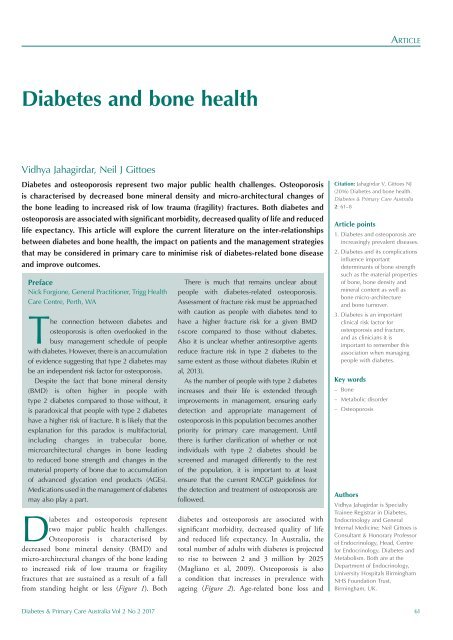DPCA2-2_issue_v3
Create successful ePaper yourself
Turn your PDF publications into a flip-book with our unique Google optimized e-Paper software.
Article<br />
Diabetes and bone health<br />
Vidhya Jahagirdar, Neil J Gittoes<br />
Diabetes and osteoporosis represent two major public health challenges. Osteoporosis<br />
is characterised by decreased bone mineral density and micro-architectural changes of<br />
the bone leading to increased risk of low trauma (fragility) fractures. Both diabetes and<br />
osteoporosis are associated with significant morbidity, decreased quality of life and reduced<br />
life expectancy. This article will explore the current literature on the inter-relationships<br />
between diabetes and bone health, the impact on patients and the management strategies<br />
that may be considered in primary care to minimise risk of diabetes-related bone disease<br />
and improve outcomes.<br />
Preface<br />
Nick Forgione, General Practitioner, Trigg Health<br />
Care Centre, Perth, WA<br />
The connection between diabetes and<br />
osteoporosis is often overlooked in the<br />
busy management schedule of people<br />
with diabetes. However, there is an accumulation<br />
of evidence suggesting that type 2 diabetes may<br />
be an independent risk factor for osteoporosis.<br />
Despite the fact that bone mineral density<br />
(BMD) is often higher in people with<br />
type 2 diabetes compared to those without, it<br />
is paradoxical that people with type 2 diabetes<br />
have a higher risk of fracture. It is likely that the<br />
explanation for this paradox is multifactorial,<br />
including changes in trabecular bone,<br />
microarchitectural changes in bone leading<br />
to reduced bone strength and changes in the<br />
material property of bone due to accumulation<br />
of advanced glycation end products (AGEs).<br />
Medications used in the management of diabetes<br />
may also play a part.<br />
Diabetes and osteoporosis represent<br />
two major public health challenges.<br />
Osteoporosis is characterised by<br />
decreased bone mineral density (BMD) and<br />
micro-architectural changes of the bone leading<br />
to increased risk of low trauma or fragility<br />
fractures that are sustained as a result of a fall<br />
from standing height or less (Figure 1). Both<br />
There is much that remains unclear about<br />
people with diabetes-related osteoporosis.<br />
Assessment of fracture risk must be approached<br />
with caution as people with diabetes tend to<br />
have a higher fracture risk for a given BMD<br />
t-score compared to those without diabetes.<br />
Also it is unclear whether antiresorptive agents<br />
reduce fracture risk in type 2 diabetes to the<br />
same extent as those without diabetes (Rubin et<br />
al, 2013).<br />
As the number of people with type 2 diabetes<br />
increases and their life is extended through<br />
improvements in management, ensuring early<br />
detection and appropriate management of<br />
osteoporosis in this population becomes another<br />
priority for primary care management. Until<br />
there is further clarification of whether or not<br />
individuals with type 2 diabetes should be<br />
screened and managed differently to the rest<br />
of the population, it is important to at least<br />
ensure that the current RACGP guidelines for<br />
the detection and treatment of osteoporosis are<br />
followed.<br />
diabetes and osteoporosis are associated with<br />
significant morbidity, decreased quality of life<br />
and reduced life expectancy. In Australia, the<br />
total number of adults with diabetes is projected<br />
to rise to between 2 and 3 million by 2025<br />
(Magliano et al, 2009). Osteoporosis is also<br />
a condition that increases in prevalence with<br />
ageing (Figure 2). Age-related bone loss and<br />
Citation: Jahagirdar V, Gittoes NJ<br />
(2016) Diabetes and bone health.<br />
Diabetes & Primary Care Australia<br />
2: 61–8<br />
Article points<br />
1. Diabetes and osteoporosis are<br />
increasingly prevalent diseases.<br />
2. Diabetes and its complications<br />
influence important<br />
determinants of bone strength<br />
such as the material properties<br />
of bone, bone density and<br />
mineral content as well as<br />
bone micro-architecture<br />
and bone turnover.<br />
3. Diabetes is an important<br />
clinical risk factor for<br />
osteoporosis and fracture,<br />
and as clinicians it is<br />
important to remember this<br />
association when managing<br />
people with diabetes.<br />
Key words<br />
– Bone<br />
– Metabolic disorder<br />
– Osteoporosis<br />
Authors<br />
Vidhya Jahagirdar is Specialty<br />
Trainee Registrar in Diabetes,<br />
Endocrinology and General<br />
Internal Medicine; Neil Gittoes is<br />
Consultant & Honorary Professor<br />
of Endocrinology, Head, Centre<br />
for Endocrinology, Diabetes and<br />
Metabolism. Both are at the<br />
Department of Endocrinology,<br />
University Hospitals Birmingham<br />
NHS Foundation Trust,<br />
Birmingham, UK.<br />
Diabetes & Primary Care Australia Vol 2 No 2 2017 61
















